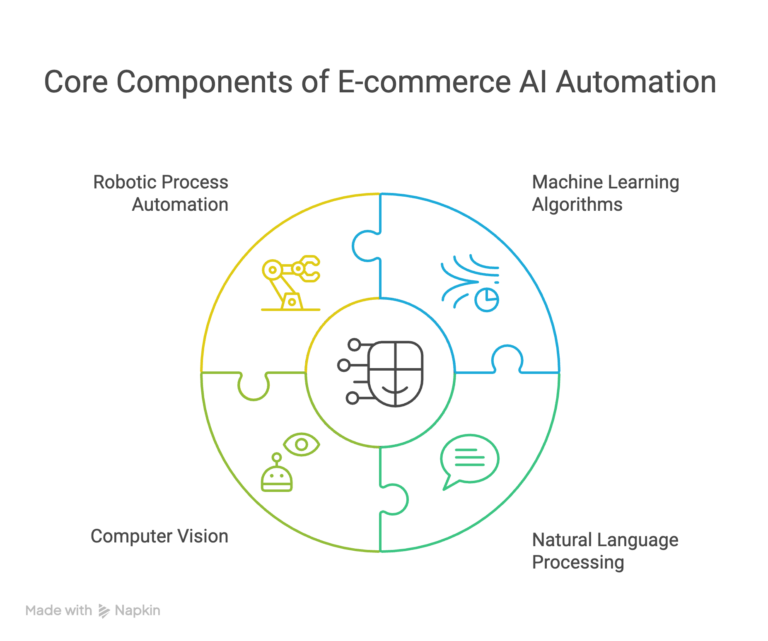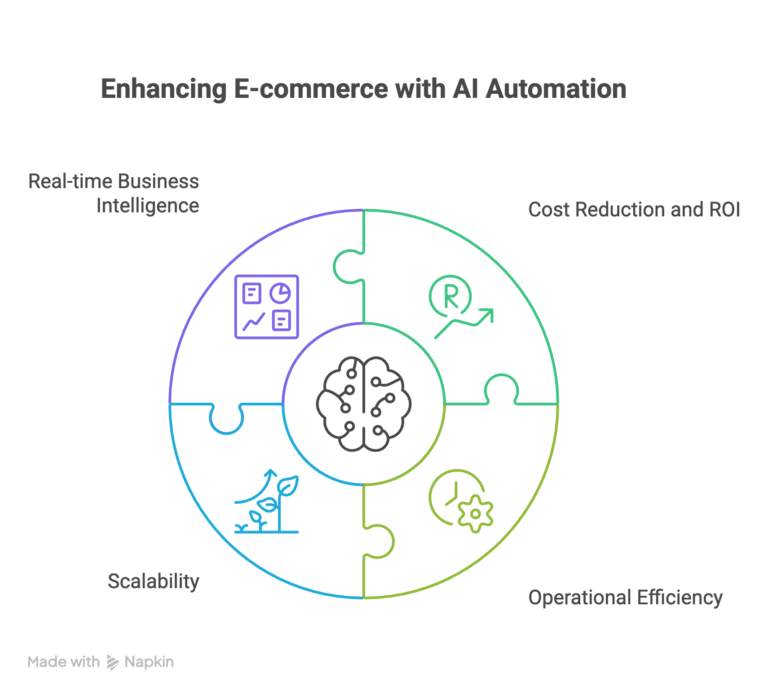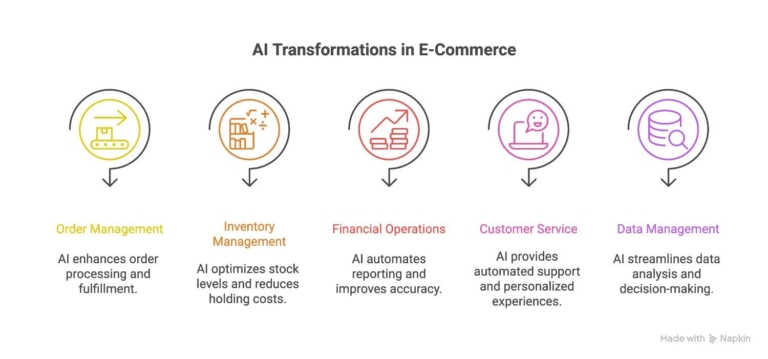Greetings! I'm Aneesh Sreedharan, CEO of 2Hats Logic Solutions. At 2Hats Logic Solutions, we are dedicated to providing technical expertise and resolving your concerns in the world of technology. Our blog page serves as a resource where we share insights and experiences, offering valuable perspectives on your queries.

Quick Summary
This guide shows you exactly how to implement AI automation for e-commerce back-office operations. Discover strategies to automate order processing, inventory management, and customer service that can reduce your operational costs. We’ll cover practical implementation steps, recommended tools, and examples to help you transform time-consuming manual tasks into efficient automated systems that work 24/7.
AI automation for e-commerce is transforming how online businesses manage their back-office operations. While you’re focused on growing sales and serving customers, manual administrative tasks like order processing, inventory management, and customer communications can quickly become overwhelming bottlenecks.
If you’re running an e-commerce business and find yourself constantly solving operational issues or watching your team struggle with repetitive manual work, you’re not alone. The solution lies in strategic automation that handles these processes efficiently.
In this article, you’ll discover exactly how to transform your back-office chaos into a streamlined, profit-generating operation.
Transform your back-office operations with AI.
What is AI Automation in E-Commerce Back-Office Operations?
AI automation in e-commerce refers to the strategic implementation of artificial intelligence technologies to streamline, optimize, and fully automate the administrative and operational tasks. These aren’t the customer-facing elements of your store, but rather the critical processes that manage orders, inventory, finances, and data.
Unlike simple rule-based automation, AI-powered systems can learn, adapt, and make intelligent decisions based on patterns in your data. They can handle unstructured information, predict outcomes, and continuously improve their performance over time.
Discover how our AI solution automated product specification generation for a major warehouse operation
Core Components of E-Commerce AI Automation

AI automation includes various components to complete the process take a look at some:
Machine Learning Algorithms: These systems analyze historical data to predict demand, identify patterns in customer behavior, and optimize inventory levels automatically.
Natural Language Processing (NLP): Enables automated processing of customer inquiries, supplier communications, and document analysis for contracts and invoices.
Computer Vision: Automates product image processing, quality control, and document digitization for seamless data entry.
Robotic Process Automation (RPA) Enhanced with AI: Goes beyond basic task automation to include intelligent decision-making capabilities.
Looking to implement AI automation in your e-commerce operations?
How AI Automation Benefits E-Commerce Back-Office Operations
The transformation that intelligent automation brings to e-commerce operations is profound. It helps to deliver measurable improvements across multiple business areas.

1. Cost Reduction and ROI
Research shows that businesses implementing back-office automation achieve an average 15.3% year-over-year decrease in operational costs. For e-commerce companies, this translates to:
- Reduced Labor Costs: Eliminate the need for additional staff as order volumes increase
- Minimized Human Error: Automated processes reduce costly mistakes in order processing and inventory management
- Optimized Resource Allocation: Free up your team to focus on revenue-generating activities instead of repetitive tasks
2. Enhanced Operational Efficiency
AI automation for e-commerce operations delivers efficiency gains that compound over time:
- 24/7 Processing: Your systems work around the clock, processing orders and updating inventory even while you sleep
- Instant Data Synchronization: Real-time updates across all platforms prevent overselling and stock-outs
- Streamlined Workflows: Automated handoffs between processes eliminate bottlenecks and delays
3. Scalability Without Proportional Cost Increases
One of the most compelling benefits is the ability to scale your business without linear increases in operational complexity or costs. AI systems can handle 10x the volume without requiring 10x the resources.
4. Real-Time Business Intelligence
Modern AI automation provides unprecedented visibility into your operations:
- Predictive Analytics: Forecast demand patterns and seasonal trends
- Performance Monitoring: Track KPIs and identify optimization opportunities automatically
- Exception Management: Get alerts for unusual patterns or potential issues before they impact customers
Want to see how much you could save with AI automation?
Key Ways AI Transforms E-Commerce Back-Office Operations
AI plays a major role in e-commerce for back-office operations find out how:

1. Intelligent Order Management and AI Automation
Traditional order processing involves multiple manual steps that are prime candidates for automation:
Automated Order Validation: AI systems can instantly verify order details, check inventory availability, and flag potential issues like duplicate orders or suspicious transactions.
Smart Order Routing: Advanced algorithms determine the optimal fulfillment center based on inventory levels, shipping costs, and delivery timeframes.
Dynamic Pricing Optimization: AI continuously adjusts prices based on demand, competition, and inventory levels to maximize profitability.
Exception Handling: When issues arise, AI systems can automatically apply business rules to resolve common problems or escalate complex cases to human operators.
2. AI-Powered Inventory Management for E-Commerce
Inventory management is often the most complex aspect of e-commerce operations, especially for businesses selling across multiple channels:
Demand Forecasting: Machine learning algorithms analyze historical sales data, seasonal trends, and external factors to predict future demand with remarkable accuracy.
Automated Reordering: Set intelligent reorder points that consider lead times, seasonal variations, and promotional activities.
Multi-Channel Inventory Sync: Maintain accurate inventory levels across your website, marketplaces, and physical stores in real-time.
Dead Stock Identification: AI identifies slow-moving inventory and suggests promotional strategies or liquidation recommendations.
3. Automated Financial Operations and Reporting
AI automation in e-commerce financial operations eliminates time-consuming manual processes:
Invoice Processing: Automatically extract data from supplier invoices, match them with purchase orders, and route for approval.
Expense Management: Categorize and process expense reports with minimal human intervention.
Financial Reporting: Generate comprehensive financial reports with real-time data and trend analysis.
Cash Flow Optimization: Predict cash flow patterns and optimize payment timing for better working capital management.
Ready to automate your financial operations? Our AI solutions integrate with popular accounting platforms.
4. Customer Service Automation and Support
Intelligent customer service automation enhances the customer experience while reducing support costs:
AI Chatbots: Handle routine inquiries about orders, shipping, and returns 24/7, escalating complex issues to human agents.
Automated Email Responses: Generate personalized responses to common customer inquiries using natural language processing.
Sentiment Analysis: Monitor customer communications to identify satisfaction issues and prioritize urgent cases.
Proactive Support: Automatically notify customers about order delays, shipping updates, or potential issues before they become complaints.
5. Data Management and Analytics Automation
E-commerce AI automation transforms how businesses handle the massive amounts of data generated daily:
Automated Data Entry: Extract information from various sources and populate your systems without manual intervention.
Data Quality Management: Continuously monitor and clean data to ensure accuracy across all systems.
Predictive Analytics: Identify trends, patterns, and opportunities in your business data automatically.
Compliance Monitoring: Ensure adherence to regulations and business rules through automated monitoring and reporting.
Implementation Strategies for E-Commerce AI Automation
Following the proper
Phase 1: Assessment and Planning
Before implementing AI automation for e-commerce, conduct a thorough assessment of your current operations:
- Process Mapping: Document existing workflows to identify automation opportunities
- ROI Analysis: Calculate potential savings and prioritize high-impact areas
- Technology Audit: Evaluate current systems and integration requirements
- Change Management Planning: Prepare your team for the transition to automated processes
Phase 2: Pilot Implementation
Start with a focused pilot project to demonstrate value and build confidence:
- Select High-Impact, Low-Risk Processes: Begin with repetitive tasks that have clear business rules
- Establish Success Metrics: Define measurable goals for the pilot project
- Monitor and Optimize: Continuously refine the automation based on performance data
- Document Lessons Learned: Capture insights to inform larger-scale implementations
Phase 3: Scaled Deployment
- Gradual Expansion: Roll out automation to additional processes based on pilot success.
- Integration Optimization: Ensure seamless connectivity between automated systems.
- Performance Monitoring: Establish ongoing monitoring and optimization processes.
- Continuous Improvement: Regularly assess and enhance automation capabilities.
Need help planning your AI automation strategy? Our experts can guide you through every phase of implementation.
Choosing the Right E-Commerce AI Automation Partner
Selecting the right development partner is crucial for successful intelligent automation in e-commerce:
Looking for an experienced AI automation partner? We’ve helped dozens of e-commerce businesses transform their operations.
Technical Expertise
Look for partners with proven experience in:
- AI and Machine Learning Development: Deep understanding of algorithms and implementation
- E-Commerce Platform Integration: Experience with major platforms like Shopify, Magento, and WooCommerce
- API Development: Ability to create seamless integrations between systems
- Cloud Architecture: Expertise in scalable, secure cloud deployments
Industry Knowledge
Your automation partner should understand:
- E-Commerce Business Models: Experience with B2C, B2B, and marketplace operations
- Regulatory Compliance: Knowledge of data protection, payment processing, and industry standards
- Seasonal Variations: Understanding of e-commerce cycles and peak period challenges
Service Approach
- Comprehensive Solution Development: End-to-end support from strategy through implementation
- Ongoing Support and Maintenance: Continued optimization and system updates
- Training and Change Management: Helping your team adapt to new automated processes
- Scalability Planning: Ensuring solutions grow with your business
Measuring Success: KPIs for E-Commerce AI Automation
Take a look at several metrics that can be used to assess e-commerce AI automation.
Operational Metrics
Processing Time Reduction: Measure decreases in order processing, inventory updates, and administrative task completion times.
Error Rate Improvement: Track reductions in data entry errors, inventory discrepancies, and order fulfillment mistakes.
Resource Optimization: Monitor changes in staff allocation and productivity improvements.
Financial Metrics
Cost Per Order: Calculate the total cost of processing each order before and after automation.
Labor Cost Reduction: Measure decreases in administrative and operational labor expenses.
ROI on Automation Investment: Track the return on your automation technology investment.
Customer Experience Metrics
Order Accuracy: Monitor improvements in order fulfillment accuracy and customer satisfaction.
Response Times: Measure faster customer service response times and issue resolution.
Customer Retention: Track improvements in customer loyalty and repeat purchase rates.
Future Trends in E-Commerce AI Automation
AI is definitely going to grow in the future, make sure to upgrade your business too.
Predictive Commerce
Advanced AI will enable predictive e-commerce automation where systems anticipate customer needs and proactively manage inventory, pricing, and marketing campaigns.
Hyper-Personalization at Scale
AI automation will deliver individualized experiences for millions of customers simultaneously, from personalized product recommendations to customized pricing strategies.
Autonomous Supply Chain Management
Future AI automation in e-commerce will include fully autonomous supply chain decisions, from supplier selection to logistics optimization.
Voice and Conversational Commerce
Integration of voice AI and natural language processing will enable more sophisticated customer interactions and hands-free business management.
Overcoming Common Implementation Challenges
Take a look at some common challenges you may face while implementing AI automation for e-commerce.
Data Quality and Integration
Challenge: Inconsistent or poor-quality data across systems
Solution: Implement data cleansing and standardization processes before automation deployment.
Change Management Resistance
Challenge: Staff resistance to automated processes
Solution: Comprehensive training programs and gradual transition strategies
System Compatibility
Challenge: Integration difficulties with existing platforms Solution: Thorough technical assessment and custom integration development
Scalability Concerns
Challenge: Ensuring automation scales with business growth Solution: Cloud-based architectures and modular automation design
Facing implementation challenges? Our experienced team can help you navigate common obstacles and ensure successful deployment.
Security and Compliance in E-Commerce AI Automation
Data Protection
Encryption: All customer and business data encrypted in transit and at rest Access Controls: Role-based access and authentication systems Audit Trails: Comprehensive logging for compliance and security monitoring
Regulatory Compliance
GDPR Compliance: Ensuring customer data protection and privacy rights PCI DSS: Secure payment processing and financial data handling SOC 2: Operational security and availability standards
Business Continuity
Backup and Recovery: Automated backup systems and disaster recovery procedures Redundancy: Multiple system redundancies to ensure continuous operation Monitoring: 24/7 system monitoring and alert mechanisms
Conclusion: Transform Your E-Commerce Operations with AI Automation
The future of e-commerce belongs to businesses that embrace intelligent automation. AI automation experts helps to positions your business for sustainable growth and operational excellence.
AI automation for e-commerce isn’t just about reducing cost, it’s about creating a competitive advantage that compounds over time. Every order processed automatically, every inventory decision optimized by AI, and every customer interaction enhanced through automation builds toward a more profitable, scalable, and resilient business.
Upgrade your e-commerce operations with AI automation.
Table of contents
- What is AI Automation in E-Commerce Back-Office Operations?
- Key Ways AI Transforms E-Commerce Back-Office Operations
- Implementation Strategies for E-Commerce AI Automation
- Choosing the Right E-Commerce AI Automation Partner
- Measuring Success: KPIs for E-Commerce AI Automation
- Security and Compliance in E-Commerce AI Automation
- Conclusion: Transform Your E-Commerce Operations with AI Automation

Related Articles







